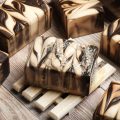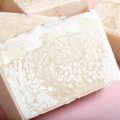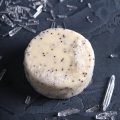This is a very simple swirl technique comes to us from our friends and Otion, and it yields dramatic end results. This is a great beginner cold process recipe, but it is important to keep the batter nice and thin during the entire process. That’s the key to getting nice rings of color and making the end swirl really pop.

What You’ll Need:
12 oz. Coconut Oil
12 oz. Palm Oil
12 oz. Olive Oil
6 oz. Aloe Vera Liquid
6 oz. Distilled Water
5.2 oz Sodium Hydroxide
1/4 tsp. Ultramarine Blue Pigment
1/4 tsp. Activated Charcoal
1/2 tsp. Tangerine Wow! Pigment
2 oz. Litsea Essential Oil
9 Bar Unfinished Birchwood Mold
Click here to add everything you need for this project to your Bramble Berry shopping cart!
If you’ve never made Cold Process soap before, stop here! I highly recommend checking out our FREE four part SoapQueen.tv series on Cold Process Soapmaking, especially the episode on lye safety. And if you’d rather do some reading, Bramble Berry carries a wide range of books on the topic, including my newest book, Soap Crafting. You can also checkout the digital downloads for that instant gratification factor.
SAFETY FIRST: Suit up for safe handling practices! That means goggles, gloves and long sleeves. Make sure kids, pets, and other distractions and tripping hazards are out of the house or don’t have access to your soaping space. Always soap in a well-ventilated area.
COLOR PREP: Before adding the lye to the oils, pour about 1/2 ounce of oil from your batch into three small containers and stir in each pigment in each container (A-M Note: I use the Mini Mixer to help work those clumps out). By doing so, you are eliminating clumps of pigment by breaking it down in advance.
ONE: Suit up for safety! This means wearing long sleeves, gloves, safety googles and making sure kids and pets don’t have access to your soaping area. Then, combine the Aloe Vera Liquid and distilled water. (A-M Note: If you don’t have Aloe Vera Liquid, you can use 100% water but the Aloe Vera Liquid adds a wonderfully nourishing touch to the recipe.) Now mix in the lye. Keep in mind, when you use aloe vera liquid as part of your lye solution, it will turn an orange color and emit a light odor that disappears after the soap sets up. Then, mix the lye solution into the oils and reach a light trace.
TWO: At light trace, stir in the fragrance and split the soap into four equal parts by pouring into the color containers and leaving some neutral in the pot (1 part tangerine, 1 part charcoal, 1 part blue, and 1 part neutral). Stir the colors in by hand. You should not stick blend after reaching a thin trace because it will only make your soap thicker. Aren’t you glad you broke down your pigments first?
THREE: Now for the fun part! Alternate pouring each color directly in the middle of your mold. Count “1…2…3…” as you pour to keep an even amount of soap distributed with each color. Shake and pound the mold on the table to even out the surface. When you are out of color, you will have created a bulls-eye pattern like this:

Note: Our trace was a little thicker than we’d like it to be. In retrospect, having a thinner trace would have allowed the layers of color to move more freely and create a better bulls-eye pattern.
FOUR: Using a bamboo skewer, start in the middle and drag the colors out to the edge of the mold. Do not lift out the skewer until you are have gone around the entire mold. The less you manipulate the swirl the better; you don’t want to overdo it and make one big blended blur of colors. Stop at the first “Wow! My swirl looks amazing!”

FIVE: Let the soap harden over night and cut it after 2 to 3 days. Allow it to cure for 4 – 6 weeks. Try different colors and see what you get! I went with a dark, medium, and light color for the most contrast.







hi, can you use more of one oil and less of the other? or maybe substitute oils for another oil in same weight.
thankyou
Hi Zul!
You can! When substituting, we recommend using oils with similar consistencies. For example, canola oil is lightweight and moisturizing like olive oil, so it would make a good substitute. You can read more about that in the Free Beginner’s Guide to Soapmaking: Common Soapmaking Oils: http://www.soapqueen.com/bath-and-body-tutorials/tips-and-tricks/free-beginners-guide-to-soapmaking-common-soapmaking-oils/
If you do increase an oil or make a substitute, make sure to run your recipe through the Lye Calculator again so you get the right lye and liquid amounts. 🙂
Lye Calculator: https://www.brambleberry.com/Pages/Lye-Calculator.aspx
-Kelsey with Bramble Berry
I just made this soap today! My first try at swirl soap. I bought the birch wood mold also. This is my first time with a wood mold, and I did not know I was supposed to line it with something? Is this true? If so, NOW what do I do????? So bummed….
Hi Wendy!
So glad you got a chance to try out the soap! We do recommend lining the mold. You can line it with freezer paper or use our easy silicone liner.
Silicone Liner for 9 Bar Mold: https://www.brambleberry.com/Silicone-Liner-for-9-Bar-Mold-P5812.aspx
How to Line Any Mold: http://www.soapqueen.com/bath-and-body-tutorials/cold-process-soap/how-to-line-any-mold/
It may be a bit difficult to get your soap out without a liner. I would recommend popping it in the freezer for about four hours before trying to unmold. That may help it pop out a bit more easily. 🙂
-Kelsey with Bramble Berry
I made a soap recipe from a book I have and used lilac fragrance oil. The whole batch seized and turned into clumps. How do I know if a fragrance is going to react like that? I have made 4 other batches with different recipes and fragrences and had no problem. Im now afraid to use fragrance!!
Thanks, Wendy
Hi Wendy!
Lilac Fragrance Oil tends to accelerate soaps. That is the case with most floral fragrances. You can find out how each of our fragrances perform in the description on the website.
Lilac Fragrance Oil: https://www.brambleberry.com/Lilac-Fragrance-Oil-P3891.aspx
If you’re working with an intricate design, it helps to choose a fragrance with no acceleration. You can also take the fragrance oil for the batch and mix it with an equal amount of liquid oil and heat the mixture up for 20 seconds in the microwave to bring the temperature of the fragrance up so it’s not quite as cold when the product is added to the soap batter.
Read more tips for working with tricky fragrances in the Soap Behaving Badly post: http://www.soapqueen.com/bath-and-body-tutorials/tips-and-tricks/soap-behaving-badly/
You can also choose a design that works with the acceleration, like this Layered Lilac Loofah Cold Process Soap: http://www.soapqueen.com/bath-and-body-tutorials/cold-process-soap/layered-lilac-loofah-cold-process/
-Kelsey with Bramble Berry
Anne
I am not clear on how the circles were poured. Was it one colour at a time and working from the inside to the outer edge? This is so inspirational.
Thanks
Ursula
Hi Ursula!
So glad you’re interested in trying this project! It makes such a pretty bar of soap :). The technique is surprisingly simple actually. All you need to do is pour your colors directly into the center of the mold, continuing to pour each color directly on top of each other in the center. Doing this will begin to push the colors below out, and you will end up with a bulleye pattern 🙂 I hope this makes sense!
-Amanda with Bramble Berry
Did you add the lye mixture right after it was mixed, or did you wait for it to cool. I can’t wait to try this.
Hi Lizzie!
This is a great question. You want the lye water and the oils to have cooled to 130 degrees or below (and are ideally within 10 degrees of each other), add the lye water to the oils and stick blend until thin trace. If a cold process recipe does not say that explicitly, it’s safe to assume 🙂
I hope this helps, and if you give this recipe a try, we would love to see it on our Facebook page! 🙂
https://www.facebook.com/BrambleBerry
-Amanda with Bramble Berry
You have inspired me to do way more than I ever dreamed! Several weeks ago, I started simple, a lavender M&P, then a dual color “scrubbie” with lavender seeds, then a 3 layer CPOP scrubbie without fragrance, then…then…then…until today when I did one of your CP dream catcher patterns with some Victoria’s Secret scent. Absolutely breathtaking!
You da man (so to speak! LOL)’
Thanks!
Good morning!
I’m so happy to hear that you’re expanding your soapy horizons! 🙂 Cold process soap making can be a little intimidating, so I’m so glad you gave it a try! Also, I’m thrilled to hear you find this blog helpful. If you ever get pictures of your soap, we would love to see them on our Facebook page!
https://www.facebook.com/BrambleBerry/
-Amanda with Bramble Berry
So PRETTY!! I am just a bit confused? The tutorial says not to take the screwer out? It looks like the swirls are supposed to start from the middle, can you explain more please??
You’ll notice that each swirl is more like a ‘petal’ and the skewer starts at the middle, goes out, rounds and then goes back in – and starts the process again. =) You could lift the skewer at each ‘out’ edge and move it back to the middle but this is a more fluid way to do the design.
Wow…that is BEAUTIFUL! Thanks for the tutorial!
Hi LuAnn!
So glad you enjoyed this tutorial! Aren’t the results beautiful? If you end up giving this a try, we would love to see your creations on our Facebook page 🙂
-Amanda with Bramble Berry